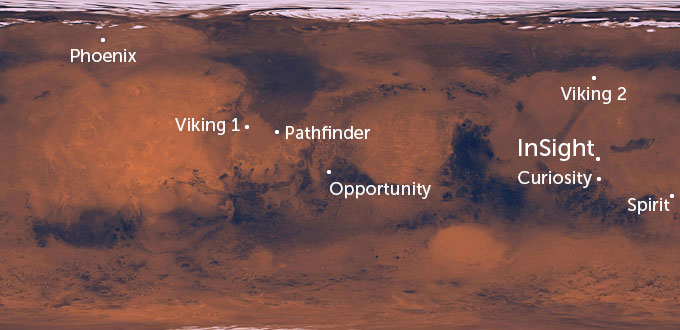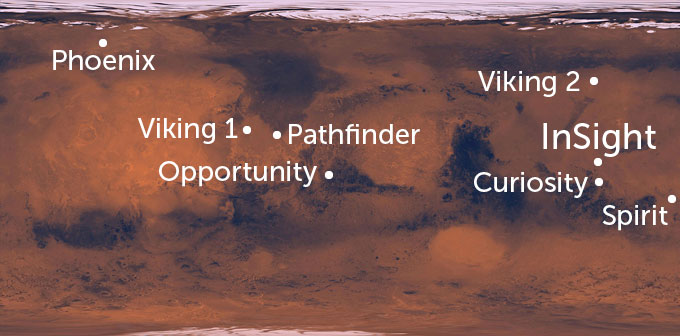Mars is not quite dead, geologically speaking.
The surface of the Red Planet trembles with Marsquakes, scientists
report, one of several first results from the NASA InSight lander’s visit to Mars.
“We’ve finally established for the first time that Mars is a
seismically active planet,” said mission lead Bruce Banerdt, a planetary
scientist at the Jet Propulsion Laboratory in Pasadena, Calif., during a
February 20 news teleconference.
InSight landed
on Mars on November 26, 2018, on a two-year mission to probe the planet’s
interior (SN: 11/26/18). The goal is to reveal more of Mars’ history and
answer questions about the formation of rocky planets in our solar system and
beyond.
To achieve that goal, InSight carries three main science
experiments. A temperature probe sunk several meters into the Martian soil will
track heat welling up from far below (though that probe has been having trouble
burrowing its way down). Radio transmissions track InSight’s position and hence
how much the planet wobbles around its axis. Results from those experiments
aren’t yet ready for prime time.
However, InSight’s seismic experiment, along with some
ancillary equipment, has turned up a wealth of new intel. Mission scientists
present results from
the first 10 months of these experiments online February 24 in Nature
Geoscience and Nature Communications.
It’s too early to know what all the new revelations mean. “We’re
really in the same situation as geophysicists were for Earth in the early 1900s,”
Banerdt said. “We’re in the wild west of understanding what’s going on.”
In the meantime, here are four things that InSight has revealed
about Mars so far.
1. Mars likes to shake things up
InSight’s seismic probe is like a stethoscope listening to
the surface of Mars for rumblings deep underground. While researchers have long
suspected that quakes gently rattle the surface of Mars, no probe before InSight
had definitively detected
one (SN: 4/23/19). As of September 30, 2019, the lander had recorded
174 Marsquakes, likely caused by tectonic activity.
“The general cause of Marsquakes is the cooling of the
planet,” Banerdt said. “The details of any particular Marsquake are still
difficult to figure out.”
Mars appears to be more active than the moon but less active
than Earth. The quakes have been very gentle, said Philippe Lognonné, a
planetary scientist at Paris Diderot University, during the teleconference.
Unless you were standing right over the epicenter with two feet firmly on the
ground, he said, you’d probably not feel most of them.
Most of the quakes have been too subtle to pinpoint their
origins. But two seemed to originate from a region known as Cerberus Fossae, a
geologically young landscape about 1,600 kilometers east of InSight strewn with
landslides, several-million-year-old volcanic flows and dried-up water
channels.
And the quakes just keep on coming. To date, the lander has
cataloged about 450 events, and the frequency is mysteriously increasing.


2. Mars has a highly magnetic personality
Unlike Earth, Mars no longer generates a magnetic field —
but it did billions of years ago, and ghosts of that magnetic field remain
imprinted in the planet’s rocks today.
Satellite images of InSight’s landing site indicate that the
rocks there are too young to have been strongly magnetized by that ancient
field. And yet, InSight measured a magnetic field coming from the surrounding
rocks 10 times as strong
as expected.
Given the age of the landscape, “the magnetization has to
come from rocks beneath the surface,” said Catherine Johnson, a geophysicist at
the University of British Columbia in Vancouver. InSight’s measurements
combined with satellite imagery suggest that the magnetic field is encased in
3.9-billion-year-old rocks buried up to 10 kilometers underground.
“The fact that we’re seeing a much larger magnetic feature
near the surface means there’s a wealth of magnetization that has been
invisible to us so far,” Banerdt said.
3. Mars feels a magnetic beat from space
InSight also picked up numerous magnetic
“pulsations” — relatively quick changes in the strength of the ambient magnetic
field. Some of these bursts, the first ever detected on Mars, last for just a
second while others last for minutes. But unlike the anomalously high magnetization
that comes from deep underground, these pulsations likely originate far above
the atmosphere.
The researchers suspect that electrical fluctuations in a
planetwide magnetic envelope induced by the sun — not the planet itself — is to
blame. Intel from NASA’s MAVEN spacecraft, which is currently checking out Mars’
upper atmosphere, may help the team connect changes on the ground to changes in
the planet’s space environment.
4. Beneath the surface, Mars is all broken up
Marsquakes can be used as probes of the Martian subsurface.
Since different types of seismic waves are deflected and slowed down by underground
materials in different ways, the Marsquakes act like a kind of planetary X-ray,
revealing how far down the planet’s crust goes and the likely makeup of that
material.
A disappointing lack in large Marsquakes has so far
prevented the team from peering as deep as they’d like. But they are starting
to get a picture of
the upper 10 kilometers or so of the planet. There is likely water — not
huge aquifers, but molecules clinging to solid mineral grains. And hidden
beneath the top layers of soil, the crust appears to be fractured by eons of
impacts from space.
The fracturing is “something that originally was thought to be the case for Mars,” said Suzanne Smrekar, a geophysicist at the Jet Propulsion Laboratory. But researchers moved away from that idea after evidence of now-dormant volcanism suggested that perhaps remnants of that pummeling had been largely smoothed over. InSight, she says, “is telling us that maybe [the crust] is a bit more broken up than people have thought recently.”

